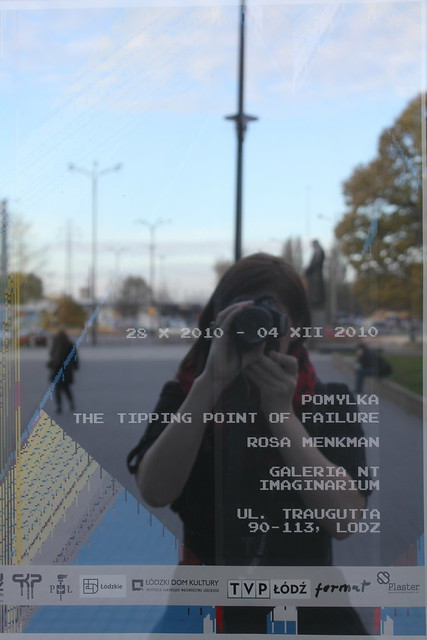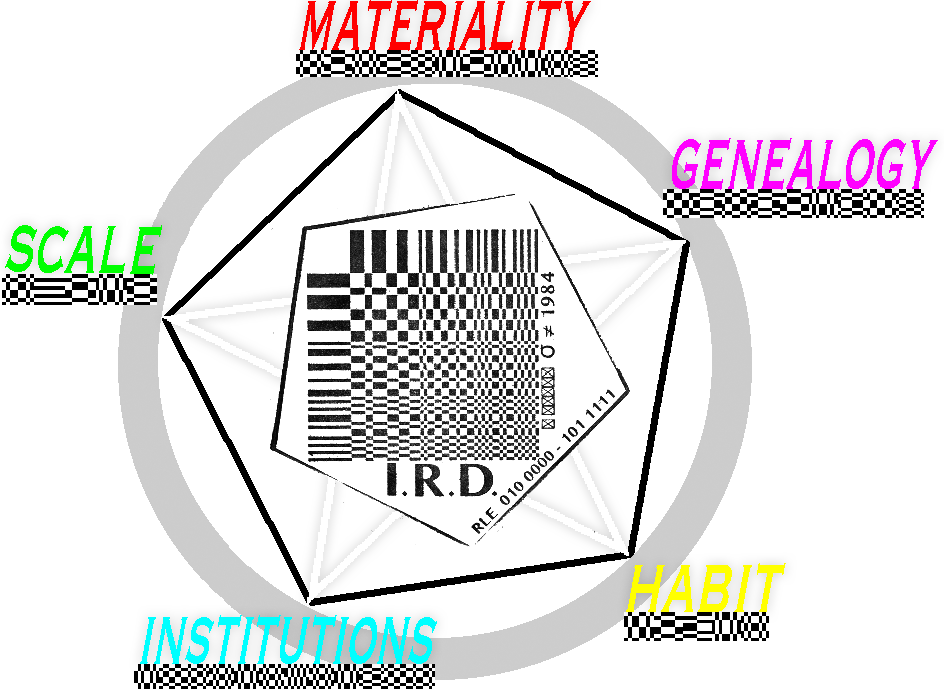The Tipping Point of Failure - Rosa Menkman
Text from the exhibition catalogue.
Modern digital cultures are inseparable from keywords like functionality, smoothness, order and progress. Interaction designers, programmers and interface developers all work together to understand and execute these mantras. But to really understand these keywords, they have to be defined in relation to what they are not. A successful product designer does not design for the average customer, but instead for the marginal, extreme customer; because when taking the margins as the rule, the middle will take care of itself. This is why studying the qualities of disfunction, irregularities, breaks, disorder, damage or even demolition are as important in the development of a new technological product as the researching of its perfect flows and this is also one of the reasons why I think it is important to study failure. The concepts of perfection and failure are a tradeoff of each other. If we want to understand and pursue perfection - we can find this in the pursuit of failure.
Over the last months I have visited many different failure (and glitch in particular) related conferences (festivals and symposia) and I have learned a lot from the different voices and perspectives within this field that is, time and time again, referred to as ‘in a constant state of flux’, ‘new’, ‘other’ or even ‘indescribable’. The more people on the floor or in the conversation about glitch, the more diverse the perspectives on glitch become; the meaning of a glitch depends greatly on the background and the conceptual application that is chosen by the person experiencing it or talking about it.
But however mysterious the definition of glitch is, I have also noticed some very pronounced patterns that emerged between the different with failure induced glitch events. Some problems, subjects, frameworks or keywords keep floating to the surface and seem to be the focal points of glitch theory at this point: subjects like P/politics, memory or preservation, genre/effect, ethics, aesthetics and design, bio/virus, copyright and economics or history have their own panel in every other conference, while words like the Other, transgressive, progressive, order, affect, uncanny, void, materiality, gender or paradox seem to be part of the obligatory failure and glitch b/lingo.
Which makes me wonder – What is the difference between failure and glitch? And if the glitch (or failure) subject is really in such a state of flux, or indefinable, how is it possible to have a reasonable conversation about it? Can glitch or failure be overcome, and where or how can it be conquered until it no longer exists as its original pure and indescribable form? In other words, where is the tipping point of failure and where is the tipping point of glitch?
In wikipedia I read: “Failure refers to the state or condition of not meeting a desirable or intended objective, and may be viewed as the opposite of success”. When I read this I know that glossary-wise this might be true, but personally I keep my reservations about subscribing to this explanation; there also needs to be place for for instance successful failure - a contradiction in terms that I would rather live with then without...
I think that wether failure should be defined in contradiction to success or not, depends on the context in which the term ‘failure’ is used. It is a very complex problem - as complex maybe as the problem of glitch itself. This is why right now I am most interested in thinking about failure in relation to the definition of glitch.
When I posed the question of failure vs. glitch in the closing panel at GLI.TC/H (a festival that took place in Chicago from 29 of September - 3th of October and that I co-organized), an interesting answer was given by Anton Marini, who declared that: “Overcoming failure is to accept it. Overcoming glitch is to incorporate it.” Which I think is was phrased excellently. Of course I also have a personal interpretation of these tipping points, which I will write up more elaborately now.
Technically, a glitch is a short lived fault or break from an expected flow within a computer system, typically experienced as an uncanny happening, a dangerous momentum of something other, unordered, unknown and unwanted; The glitch is where the digital flow fails to answer to our expectations.
The glitch fulfills the role of 'Other’ - it is the utterance of a computer that does not subordinate to the societal norms and rules or protocols its users and programmers have implemented upon it. It is the behavior that does not fit-in and is usually avoided or if possible, completely excluded from the system (by for instance debugging).
After the momentum of the failure, there are a couple of possible ways the glitch can ‘tip’. First of all, if the cause of the computers erratic behavior comes to the light, the glitch disappears and what is left after this is the effect of a bug that (often) has a certain debugging method. If the cause of the failure stays unknown, the momentum of glitch transforms into a phenomenon (or the memory thereof) that gains meaning from its context; the person who experiences the glitch, the technology that is malfunctioning and other perspectives that are at stake. In any case, the uncanny momentum of glitch is open to symbolical or metaphorical connotations - that take the interruption away from its strictly technological being. This openness of glitch is what glitch artists play with and is what makes glitch so hard to define.
In my opinion failure can thus be considered as the primary, under-developed state of glitch, which it will inevitably (and fast) tip away from. Failure is the static point of glitch, frozen in time, yet only nano seconds long, while its tipping point marks the active flow in which the glitch moves away from failure into and through its many new possible conceptions. The tipping point of failure thus marks the inclusion of glitch into or the conception of glitch as a paradigm, which can but does not need to demystify it.
In the case of glitch-art, the roles of failure and glitch are inevitably more complex because the definitions of glitch and its tipping point(s) are more complex - depending of course on the perspective chosen - it moves away from a strictly technological definition to a more metaphorical one. My stand points on glitch-art are therefore multiple and never followed each other in a clean, clear-cut order. But for the sake of clarity I will try to describe it here as linear as possible.
My exhibition ‘The Tipping Point of Failure’ is about the role of failure in my different phases of glitch art. In my first practical glitch-art I passively framed accidental glitches; the monumental failures of the computer. I collected glitches that resulted from active tinkering and explored new ways in which I could exploit the computers failing draw-capabilities. I also moved along with re-programming and pre-programmed glitches.
These first stages are marked by my fascination with hunting down a formal aesthetics of failure that was (or was not) based on technical crudeness; an impetuous glitching that slowly commodified the dynamics, the norms and values of what once was digital punk - although I did not (always) realize this.
The work that symbolizes this development is The Vernacular of File Formats; A collection of 7 videos and 10 file format-images in which I actively demystify these most used glitch-effects. In this work I show that the tinkered-glitch has already been transformed into a filter and something that could even be called a commodity or paradigm - but the work also raises the question if this kind of glitching has actually always already been a ready-made commodity (instead of a new form..).
My Videoscapes, Glitch Studies Manifesto and the Collapse of PAL show the changing role (or tipping point) of failure in my work. In these works or ‘other’ phase of my glitch-art I am trying to make more conceptualized or narrative glitch-art. While failure sometimes still plays a role, the starting point of these works lies within the exploration of a concept, a call for studying glitch itself or even a narrative rather then failure itself.
The exhibitions “the Tipping Point of Failure” does not only refer to the inception of glitch, but should thus also be understood as a critique to the one dimensional “Aesthetics of Failure” that glitch-art is so often aligned with. It is an ode to everything that can happen after the tipping point of failure - within the realm of pure, not yet described glitch-art.




No comments:
Post a Comment